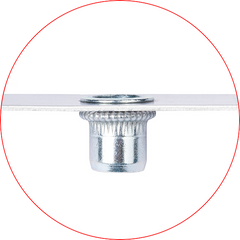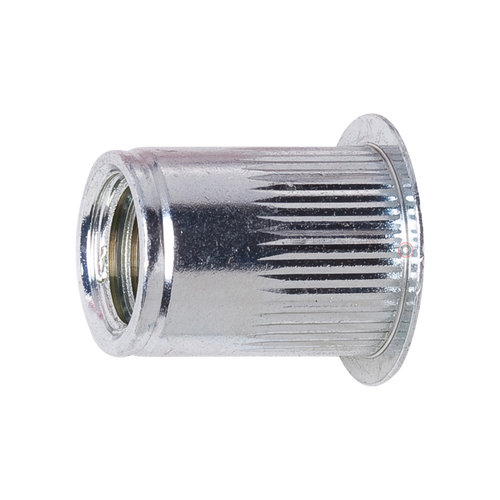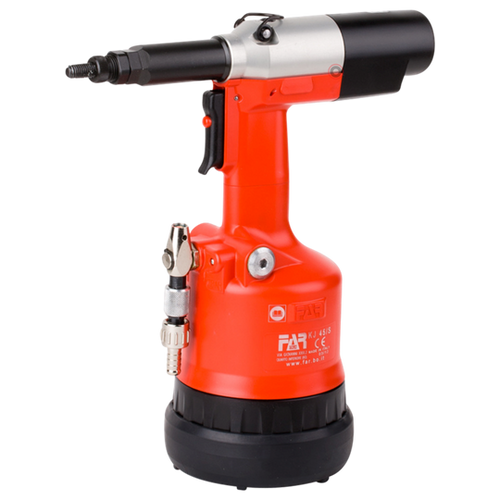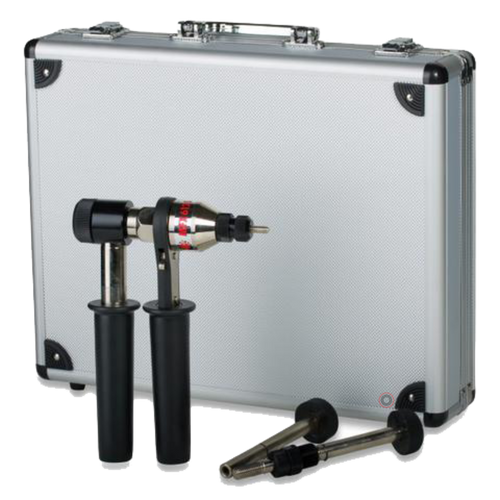RivnutLab Troubleshooting Guide
What is a Rivnut? Understanding rivnuts and how they work.

A rivnut, also known as a rivet nut, nutsert or nut insert, is a type of fastener used to create a threaded hole in materials that are thin or where access to the backside is limited. When assembling sheet metal components, its important to use strong, load bearing threads that won't strip out under pressure. Screws, bolts and rivets are good fastener examples, however what if you need a fastening system that allows you to attach and remove linked pieces in your assembly.
Rivnuts are a strong, durable and removal solution that permits you to attach and remove linked pieces in your workpiece. They are commonly used when joining metal sheets or other materials that are too thin to support a tapped thread. A rivet nut consists of a cylindrical body with a threaded interior and a flange at one end. The exterior of the body may have ridges or knurls to provide better grip and prevent rotation, like our Xtralok nutserts. The other end of the rivut is predominately open to allow for the installation of a bolt. They are an easy solution that requires a rivnut tool to install them (here at Aerobolt we call them nutsert tools).
Rivnut Installation Issues.
Installing rivnuts can sometimes be tricky, so we have created this rivnutlab page to address the most common installation issues. The pictures below show the difference between an incorrectly installed rivnut (pictures 1 & 2) and a correctly installed rivnut (picture 3).
1. Inadequate Bulge.
The rivnut is not gripping the material correctly, causing the rivnut to spin whilst installing the bolt. In this instance, remove the nutsert and check the stroke on the tool before attempting to install another.
2. Over-stroked Bulge.
This can cause the parent material to buckle, or cause the rivnut to tilt on one side and/or lose the internal thread, resulting in an uneven thread and resistance to the bolt being threaded through.
3. Correct Bulge.
When installed correctly, there is no tilting and the rivnut is well balanced between gripping the material and allowing a bolt to be threaded through with no resistance.



Other rivnut installation issues:
Stripped thread: this is most probably caused by too much stroke or tension, or due to the tool mandrel being bent/damaged.
Tilting rivnut: The quality of the rivnut may be questionable, the tool mandrel is bent or the anvil size may not be correct.
Scratched head: Check you have the correct size anvil on the tool.
How do you install a rivnut?
A rivnut is tubular in shape, and much like a regular rivet its placed in a pre-drilled hole and compressed into place via an air, cordless or manual rivnut tool. Installation is easy via the following steps.
- Step 1. Thread the rivnut onto the mandrel of the tool, some tools spin themselves to load the rivnut.
- Step 2. Place the rivnut into the pre-drilled hole & activate tool to begin swaging process. Tool’s mandrel will pull up rivnut causing body to collapse & bulge out 360°.
- Step 3. The rivnut has now bulged & created a lip on the blind side of the material and has firmly interlocked itself onto the material.
- Step 4. rivnut tool will either automatically or manually reverse out of the rivnut. Once installed it creates a permanent internal threaded component in a sheet metal workpiece.
What's the difference between rivnut & nutsert?
Nutserts, and rivnuts are labels for fundamentally the same fastener type. The generic term is rivet nut, however there are other tpopular erms for the same fastener, such as nutserts, rivnuts and threaded inserts. Over time a number of company brands and their trademarks of these products have become the default product name.
What are the benefits of rivnuts?
Rivnuts provide a quick, reliable, low-cost component used to fasten two pieces of sheet metal together.
Key Rivnut Benefits.
- One side assembly for fast installations as access to the rear is not required.
- Highly resilient, forming a permanent superior thread for the attachment of a bolt/screw.
- Assembly and disassembling components with ease.
- Easy installations with minimal training. rivnut tools are robust & readily available.
- Can be used to assemble two or more materials, like a rivet.
- Installs into galvanised or pre-painted material without damaging surface.
- Using rivnuts is safer than welding with no harmful vapours, heat or dust.
- Installs into a wide range of material gauges due to its high grip range tolerance.
What are the different type of Rivnuts?
There are 2 main options; Round body rivnuts & Hex body rivnuts.
Round Body Rivnuts.
Round body rivnuts are the most popular option, especially the knurled body rivnuts (Nutsert "xtralok") due to their great resistance to spinning whilst being installed and vibration after installation. They have a low-profile wide flange head with the option of open or closed end in steel, stainless (304 & 316 grade) and aluminium.
There are a couple of other round body options, including the smooth body rivnuts, and the slotted or split body Plus Nuts or Jack Nuts. The slotted body rivnuts are ideal for lightweight material like plastics, fiberglass, and composites.
Hexagon Shape rivnuts.
Hexagon shaped rivnuts are designed for use in punched hex shape holes and provide exceptional resistance to spinning (i.e. they cannot be unscrewed). Here at Aerobolt we have two options, and this includes (1) Half Hex (half hex & half round body) and (2) Full Hex shape for extra strength (predominantly hex shape body). We also have open or closed end hex rivnuts in steel or stainless.
SELECTING THE RIGHT TOOL FOR RIVNUTS.
After you have selected the correct rivnut to suit your application, you will need to consider tools. There are 3 main options that include air, cordless or manual.
Air rivnut tools
For frequent rivnut installation, pneumatic (air-powered) is the easy choice. Air rivnut tools offer fast installations with consistent results. Some of the pros include: Easy to use—the tool spins the mandrel to thread the rivnut, then retracts to collapse the body of the rivnut with little physical exertion required. The tool will pull to either a set pressure or a set stroke. Cons: Require an air source such as a compressor, possibly limiting mobility and making remote use impractical.
Manual rivnut tools
For the occasional installation of rivnuts, manual tools are your most cost-effective option. They work by adding the rivnut to the end of the tool, squeezing/torquing, and retracting the tool from the now applied rivnut. Some of the pros include: Inexpensive, easy concept, great for the handy person. Cons: They require physical force to use.
Cordless battery rivnut tools
Cordless rivnut tools run on battery power and provide incredible versatility, hence allowing you to install rivnuts from practically anywhere. Like pneumatic tools, battery-powered tools are basically point-and-shoot. Pros: Mobility, speed. Cons: Batteries have limited charge before needing to be plugged in again, cost.
1001 RIVNUT APPLICATIONS.
Rivnuts have 1001 uses which make them suitable for various applications such as; automotive manufacturing, aviation, balustrades, commercial kitchens, commercial furniture & fit-outs, electrical appliances & switchboards, Emergency vehicles, Farming equipment, HVAC (Heating, ventilation & air conditioning), medical equipment, military equipment & vehicles, Playground equipment, sheet metal fabrication, solar installations, refrigeration, RV Vehicles, Trucks & Trailers, Ute canopy bodies, Utility vehicles and so much more.





